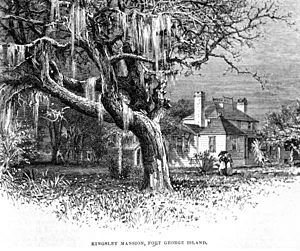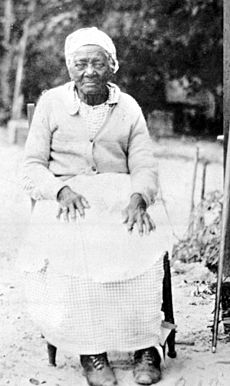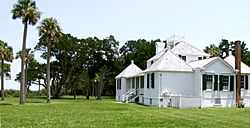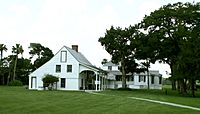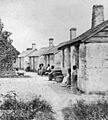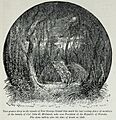Kingsley Plantation facts for kids
Quick facts for kids |
|
|
Kingsley Plantation
|
|
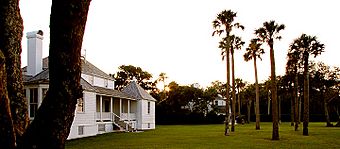 |
|
| Location | within the Timucuan Ecological and Historic Preserve, Jacksonville, Florida |
|---|---|
| Nearest city | Jacksonville, Florida, U.S. |
| Area | 60 acres (24.3 ha) |
| Built | 1797 or 1798 |
| NRHP reference No. | 70000182 |
| Added to NRHP | September 29, 1970 |
Kingsley Plantation is a historic site on Fort George Island in Jacksonville, Florida. It was once a large farm, called a plantation, owned by a man named Zephaniah Kingsley. He lived there for 25 years. Today, the site is part of the Timucuan Ecological and Historic Preserve and is managed by the U.S. National Park Service.
The plantation is famous for having the oldest plantation house still standing in Florida. It also has a village of slave cabins that is one of the best-preserved in the United States. These buildings give us a glimpse into what life was like in the early 1800s.
The main business at Kingsley Plantation was buying, training, and selling enslaved people. Growing crops like cotton was a smaller part of the business. Because the plantation was isolated, the people living there also had to grow their own food in small gardens.
After Kingsley's time, other people lived on the plantation. In 1955, the State of Florida bought the property to protect its history. It became part of the National Park Service in 1991, so everyone can visit and learn from it.
Contents
The Story of Fort George Island
Early Inhabitants and European Settlers
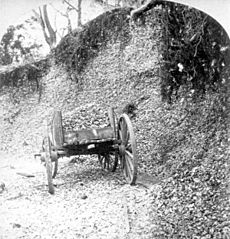
Long before Europeans arrived, Fort George Island was home to Native Americans. The Saturiwa, a Timucua tribe, lived in the area. They left behind huge mounds of oyster shells, which show how important fishing was to them.
In the 1500s, Spanish and French explorers came to Florida. Spain eventually took control and set up missions to convert Native Americans to Christianity. One mission, San Juan del Puerto, was on Fort George Island.
Later, in 1763, Great Britain took control of Florida. The British started large farms, or plantations, in the area. The first plantation on Fort George Island was started in 1765 by Richard Hazard, who grew indigo plants using the labor of enslaved Africans.
After the American Revolution, Spain got Florida back. A man named John McQueen started a new plantation on the island in 1793. He built a large house, but he ran into money problems. The plantation was then taken over by John Houston McIntosh, who later had to flee Florida after a failed rebellion against the Spanish.
The Kingsley Family
Zephaniah Kingsley was a slave trader and ship owner who bought the Fort George Island plantation in 1814. He lived there with his family, which was unusual for the time. His wife, Anna Madgigine Jai, was a woman from West Africa whom he had purchased as a slave when she was only 13. He later freed her and their three children in 1811.
Anna was a very capable person. She managed one of Kingsley's other plantations before moving to Fort George Island, where she oversaw the work of 60 enslaved people. They grew crops like sea island cotton, citrus, and corn.
Kingsley had relationships with three other African women who were also his co-wives. Anna was the head of this large, multiracial family. Kingsley was proud of his family and gave his children the best education he could.
Under Spanish rule in Florida, free people of color had certain rights. But when the United States took control, new laws began to take those rights away. Kingsley argued against these new laws. He believed in a three-part society with white landowners, enslaved Black people, and a class of free people of color with rights.
Because of the new, stricter laws in Florida, Kingsley moved his family to Haiti, which was a free Black republic. He sold the Fort George Island plantation to his nephew, Kingsley Beatty Gibbs, in 1839.
Life After the Kingsleys
After the American Civil War, the island was managed by the Freedmen's Bureau, an agency that helped newly freed African Americans. Many of them lived in the old slave cabins and farmed the land.
In 1869, a farmer named John Rollins bought the island. He turned it into a tourist resort and built a large hotel. The slave cabins were even shown to tourists as an attraction. After the hotel burned down, the Rollins family grew citrus trees until a freeze destroyed their crops.
In the 1920s, private clubs were built on the island for wealthy Jacksonville residents. The main plantation house was used as part of a club for a while.
Finally, in 1955, the Florida Park Service bought most of the island to preserve its history. In 1991, it was transferred to the National Park Service, which cares for it today.
Life for Enslaved People on the Plantation
Kingsley's main business was slave trading. He would bring enslaved Africans to the plantation, where they were taught some English and trained to do farm work. This training made them more valuable when they were sold to other plantation owners.
The enslaved people at Kingsley Plantation worked under a "task system." Each person was given a certain amount of work to do each day. For example, a person might have to process 20 pounds of cotton. Once their tasks were done, they had free time to work in their own gardens, fish, or rest. This was different from the "gang system" used on other plantations, where people were forced to work all day under an overseer.
Archaeologists have studied the slave cabins and found many artifacts. They found cooking pots, animal bones from meals, and tools. These discoveries show that the enslaved people, who came from different parts of Africa like Nigeria and Guinea, kept many of their African traditions alive.
The Slave Cabins
The slave cabins at Kingsley Plantation are special because they were built from a material called tabby. Tabby is a type of concrete made from burning oyster shells to create lime, then mixing it with water, sand, and whole shells. This mixture was poured into wooden forms to build strong, durable walls.
There were originally 32 cabins arranged in a large semicircle. This layout is very unusual for a plantation in the United States. Some historians think Anna Jai may have designed it this way, as it is similar to how villages were built in West Africa.
Each cabin had one room, a fireplace for cooking and heat, and a loft for sleeping. The tabby material made the cabins resistant to weather and insects, and it kept them cooler in the summer and warmer in the winter. Today, 23 of the original cabins remain in various states of ruin, and one has been restored to show what it looked like in the 1800s.
Buildings and Structures
The Owner's House
The main house was built around 1798 and is the oldest plantation house in Florida. It has a unique design with a large central room and four smaller rooms at each corner. This design helped air flow through the house to keep it cool. The house faces the water and has porches on both the front and back.
When Kingsley lived there, a brick path connected the house to a dock on the water. The house was a safe place during attacks and raids in the early 1800s. Over the years, different owners made changes, like adding rooms and electricity.
The Kitchen House
Next to the main house is a two-story building that served as the kitchen. The ground floor was for preparing food, while the second floor was where Anna Jai and her children lived. This was common in West African cultures where wives often had separate living spaces from their husbands. The building became known as "Ma'am Anna House."
The Barn and Other Structures
A large barn made of tabby stands near the owner's house. There are also ruins of another tabby house on the property. According to Kingsley's will, this house was left to his fourth wife, Munsilna McGundo, and her daughter.
Kingsley Plantation Today
Today, Kingsley Plantation is a place where people can learn about the complex history of Florida. Visitors can see the owner's house, the kitchen house, the barn, and the remains of the slave cabins. One cabin is restored to show what life was like for enslaved people.
The National Park Service works to preserve these historic buildings. The site hosts a Kingsley Heritage Celebration each February, where descendants of the Kingsley family gather. The event includes music, storytelling, and talks by historians and archaeologists.
See also
Images for kids




